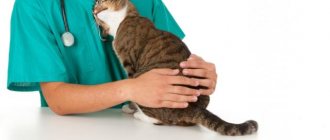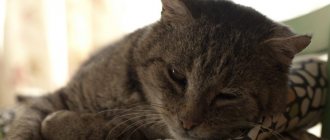Mating cats and female cats is a difficult procedure, for which it is important to prepare in advance. All the details of the mating - from choosing a suitable partner to trimming the pet's nails before the meeting - fall on the shoulders of the animal's owner and determine the success of the upcoming event. Mistakes made can lead to health complications for your pet or to a lack of results. At what age can male cats be allowed to mate and the peculiarities of its course, we will tell you further.
Mating cats and cats: how does it happen?
First mating
The first mating of a cat should be carried out at the age of at least 10 months.
You can breed a cat with a cat after the completion of basic growth and development and the complete formation of the genital organs. Only the fulfillment of these two conditions will make it possible to obtain numerous and full-fledged offspring without damage to the body of the expectant mother.
For cats, the ideal time for the first mating will be 10-15 months of age, but no later than one and a half years. Almost all breeders recommend skipping the first two heats and only then unleashing them.
Important! A cat should not give birth more than three times a year. Late insemination is also undesirable - it can lead to disruption of the reproductive cycle with all the ensuing problems:
Late insemination is also undesirable - it can lead to disruption of the reproductive cycle with all the ensuing problems:
- false pregnancy,
- inflammatory processes in the uterus,
- polycystic disease,
- exhaustion,
- stress, etc.
Breeding use of males is permitted after the first year of life.
Can a neutered cat mate with a female cat?
Some owners are surprised to discover that their pet, even after castration, shows interest in the opposite sex, and sometimes even tries to mate with a cat. How can this be if the operation was carried out specifically to make the male indifferent to the females? In fact, it is not uncommon for a neutered cat to mate with a female cat, but only if he already has such experience. That is, if the pet has already known the “taste of love” before the operation, and now does it, rather, out of habit. But, of course, he will have no more offspring.
If the male was castrated before his first mating, then mating with the female is impossible. If only because the cat simply does not know what it is and why it is needed. It also happens that a beloved pet continues to stubbornly ask for a cat after surgery. Don’t be surprised or panic, the cat’s testosterone levels have not dropped yet. Just be a little patient and it will pass soon. This condition will not last long; it is a kind of side effect of the operation.
Gulena cat: all the subtleties of the process
There is an opinion that a cat wants a cat in the spring, or more precisely, in March. And it is true... in relation to the “correct” cats living “in nature”. Natural laws tell them to walk in the spring, feed their offspring in the warm season, and in the cold, think only about survival. Unfortunately or fortunately, the sleek, mustachioed pets who live in our homes look down on this opinion. A sweet life and a good diet lead to the fact that they are ready to reproduce throughout the summer and autumn months, and even winter.
At what age does a cat start asking for a cat?
What time do cats start walking? It depends on its breed: usually a cat begins to ask for a cat for the first time in the sixth to tenth month of life. However, despite the onset of puberty before the age of one year, she is not always able to give birth to healthy babies at this time. If a cat wants a cat for the first time, it is advisable not to let them meet at least until the age of one and a half years.
Signs of estrus in a tailed “bride”
What signs in an animal's behavior indicate that a cat wants a cat? There are a lot of them, and it’s difficult not to notice the signs that a cat has gone on a spree:
- the cat screams both day and night, trying to run away from the house;
- cannot stay in one place;
- cuddles up to people and rubs against objects;
- calm cats become aggressive, and vice versa;
- rolls on the floor, lifts its tail up or to the side, tramples with its hind legs, as if squatting on them;
- loses appetite or almost refuses to eat;
- noticeable discharge from the genitals;
- urination becomes more frequent.
How often does a cat ask for a cat?
How many days does a cat walk? The duration of her estrus varies from person to person. But the end of this period, when the cat has gone on a spree, does not mean at all that the owners can relax for a long time: if the “bride” did not manage to meet the “groom”, screaming and rolling on the floor can resume after a week or two. And to the question “how many days does the cat ask for the cat?” the exhausted owners answer: “all 365 in a year!” How this looks in practice, look at the video (Alexey Karasev).
How long does a cat walk?
How long does the cat ask for the cat? The duration of estrus is usually from 7 to 20 days. If the “bride” does not become pregnant, then the “wedding requirements” will be repeated every 14-21 days until she is expecting children or the resting season begins. Occasionally, a third option is also possible, the so-called false pregnancy, which postpones the appearance of a new period when the cat wants a cat.
Stages of heat
The estrus process can be roughly divided into four stages.
- The first is called proestrus. It lasts from 1 to 4 days and is characterized by the relative calm of the animal. The beginning of the period when the cat went on a spree is indicated only by quiet throaty meows and obsessive caressing of the owners. The tailed cat is not yet ready to meet a roaming cat.
- The second period, estrus, can last 7–10 days. The female begins not just to scream, but to scream at the top of her lungs. When you stroke her back, she crouches, moving her tail to the side. This means they are ready to mate. If you want to let her have a kitten or several, it is better to bring a male on the 3rd-5th day of estrus.
- In the third period, metestrus, which lasts from 3 to 12 days, the pet that has walked with the “groom” will drive away all applicants. When fertilization does not occur, a false pregnancy may begin, very similar to the real one, but not ending in childbirth. True pregnancy in your pet lasts 60–70 days.
- In the last, fourth period, called anestrus, she calms down.
Cats in heat
If males are hypothetically ready to mate at any time of the day or night, then the reproductive system of cats is somewhat more complex and involves adapting the partner to it. In the same case, if we are talking about a planned mating, the owner of the female must adapt accordingly. Preparation for mating will not be successful if the owner of the pet is not aware of the stages of estrus, which we will talk about later.
During estrus, a cat's genitals are in constant tension.
Stages of heat
There are four stages of estrus in cats, and mating can only take place during one of them.
Table. Stages of estrus in cats
| Stage | Description |
| Proestrus | The stage lasts from one to two days and can be called “introductory”. It is characterized by general anxiety of the cat, not supported by any objective reasons. The pet may rub against the owner’s legs or walk with characteristically bent knees |
| Estrus | The stage reserved for the heat itself and lasting one and a half weeks. It is characterized by the entire list of manifestations described in the previous chapter. It is during estrus that the cat is ready for mating, and mating carried out from 3 to 5 days will be most effective. The peak of estrus is often accompanied by a loud meow, which can be mistaken by owners for severe pain. |
| Metaestrus | The stage of gradual attenuation of sexual desire, which can last from two to ten days depending on various circumstances. Despite the gradual "calming" of the cat, she may still experience secretions from the vagina, which soon stops. During metaestrus, it is useless to plan mating, since the cat begins to perceive the cat’s attempts to establish contact with pronounced aggression |
| Anaestrus | The final stage, which involves complete calming of the cat until the next heat. In this state, the pet has absolutely no desire to participate in mating, and any attempts by the owner to change the situation are unsuccessful |
Failure to comply with the correct time frame can lead to various complications such as disruption of the entire reproductive cycle or false pregnancy , which leaves an imprint on the cat’s health. Frequent disturbances of the reproductive cycle lead to such dangerous consequences as:
- pyometra;
- endometritis;
- neoplasms in the uterus.
One of the worst consequences of untimely mating can also be miscarriage and frequent miscarriages in cats .
How to recognize a false pregnancy in a cat and what methods are used to treat this disease can be read below.
False pregnancy in cats
Features of the course
Unlike the human reproductive system, the cat's does not stop its active activity. Accordingly, estrus continues in cats regardless of their age - among felines there is no such thing as menopause. However, with age, periods of estrus gradually shorten, and the pauses between them become longer.
As cats age, estrus occurs less and less frequently.
Continuous periods of estrus do not mean that the cat can be used to bear offspring until death. The most favorable period for pregnancy in females is considered to be from one and a half to six to seven years of age (again, depending on the breed). Both very young and older cats can have a difficult pregnancy, which will present additional and unnecessary difficulties for the owner.
Video - Characteristics of a cat during estrus
Features of mating purebred cats
Owners of purebred cats should approach the choice of a partner for mating responsibly - this determines what the offspring will be like. To prevent kittens from inheriting breed defects, you need to choose an ideal mother for them. A “pure” pedigree in a cat will guarantee the absence of physical and genetic abnormalities in the offspring. For successful mating, it is good if both parents have outstanding sires in the family. Specific rules for breeding animals are established by the clubs themselves.
When breeding purebred animals, their blood types must be taken into account so that the kittens do not develop hemolysis, a deadly disease. Therefore, carefully study the compatibility of animals according to this factor. For example, if a cat has group B, then he can be bred with any cat, and if he is A, then mating with a cat with group B is excluded, etc. Don't know your blood type? Then it is worth taking the appropriate test from a veterinarian in advance.
If your cat participates in exhibitions, then take into account their schedule. It is better to breed an animal after an exhibition so that the appearance of the pet does not let us down, since matings directly affect the exterior (coat quality, etc.).
Partner selection
You need to start looking for a partner for your pet in advance. A more mature partner is selected for a young, inexperienced cat, and an experienced “lady” is selected for a young “gentleman”. If this is the first meeting for both animals, contact may not occur.
The easiest way is for owners of purebred cats with a pedigree: the club selects a partner for them. They can also help you choose a cat for a non-club cat. The main thing is that the animal has a veterinary passport with vaccination records. Fourteen days before the intended mating, the cat must be wormed. If there are problems with the ears or eyes, these should also be addressed in advance.
No matter how long the future “spouses” have pedigrees, their children will not be considered purebred without an officially formalized agreement. It can be obtained from the felinological club or found on their website. The contract specifies full information about the parents, the date, month and year of the mating, and under what conditions it was carried out. Enter information about breeders. There should be two such agreements - for both owners. In addition, breeders need to make a copy of their animal's pedigree and a photocopy of their own passport in advance, which they will then exchange.
The parents themselves must be registered in the club, not have any defects that prevent procreation, that is, belong to the breeding or show class, undergo an examination at a veterinary clinic and have the appropriate entries in their passport.
As payment for mating, a kitten is most often taken, the sex of which is chosen by the cat's owner. Sometimes, if there are no kittens of the desired sex in the litter, payment is made in money. The breeders agree on the amount personally.
There are some things to keep in mind:
- You cannot breed a cat younger than ten months; such kittens are not registered anyway;
- No more than three litters are registered within two years;
- It happens that litters from different cats can have the same defects. In this case, the cat is not allowed to reproduce; it must be sterilized. They do the same with a cat.
Offspring
A cat is capable of giving birth to 5–6 kittens 2–4 times a year.
All kittens are born with straight ears. “Sagging”, that is, the formation of a fold in 50% of kittens begins from the 21st day of life, if the parents are selected correctly. At this time, it is determined which type of breed - straight-eared or fold-eared - each kitten belongs to.
Kittens grow quickly. From 3 months, their body, legs and head become elongated, which does not look very attractive. But by the age of 8 months, the appearance of the pets becomes harmonious. And by the age of 3, cats are fully formed.
READ Description of the Limousin cattle breed, dignity and its breeding.
Briefly about puberty
It is an open secret that the onset of puberty in a cat occurs earlier than the onset of physiological maturity. Puberty means the female’s readiness to bear offspring, and the male’s readiness to fertilize the cat’s egg. As for females, they become sexually mature after about six months from birth. This does not mean that after six months it would be worth looking for a cat and getting a couple together. Early pregnancy may have some not very pleasant consequences:
- slowdown in cat development;
- a weak offspring may be born;
- the vlomyak cat will endure the pregnancy period;
- this may be the only pregnancy.
From time to time the female will “flow”, the best option would be to start looking for a suitable sire. And it’s a matter of stopping at two or three males, from which over time you can choose one.
Males are allowed to talk about puberty when they are eight months old. At this time, castration is allowed, but it is too early to think about mating the cat. Males can also have negative consequences due to early mating, including:
- rallentando of the growth process;
- deterioration in appearance;
- risk of impotence.
Due to this, when breeding animals after they reach puberty, you only need to wait a little.
Second phase
You should not immediately try to pick up the cat, as this will most likely result in injuries - bites and scratches.
First, the cat is accustomed to your hand by placing it palm down on the floor; you can place the cat’s favorite toy nearby. You need to wait until the cat comes up and rubs itself on your arm or leg. In this way, she wants to make sure that the object present is not dangerous. If a person initiates contact, the animal may respond with an attack.
If the cat attacks, pick him up early
If the pet has given the go-ahead, the palm is slowly raised to eye level and held in this position for a while. Then they begin slow stroking. You need to stop before the cat gets tired of close contact with a person.
You should not drive away a cat if it climbs onto your lap, even when there is no time for tenderness. Then it will be more difficult to achieve such trusting behavior.
Mating is a responsible matter
Before mating two animals, each owner should ask themselves a few questions regarding whether they want to have additional offspring, look for potential partners for this, and take part in exhibitions in the future. Sometimes the search for a cat or female for breeding can drag on for a long time due to the difficult nature of the pet or pet. And to participate in exhibitions in the future, you will have to spend significant sums on vaccinating kittens and caring for them.
Sometimes owners do not know at all what to do with the offspring that are born. It becomes a heavy burden that many strive to get rid of. Thus, in order to avoid a number of problems, it is worth thinking about whether all this is necessary now or should you postpone mating until next time?
If all the questions asked have been answered positively, and the pet owner is ready to support and care for future offspring, then you can begin to look for a partner for the cat and carry out the mating process.
Features of the first mating
The first heat of an animal, when the cat begins to ask for a cat for the first time, is not a signal for immediate mating with the cat, but owners who are planning offspring should begin from this time preparations for further mating. It is also impossible to delay this procedure, so as not to provoke the development of negative consequences. Pets must either be sterilized on time or be mated according to all rules. If you delay it, it will cause a disruption in the physiological cycle, contribute to the exhaustion of the body, or lead to various diseases of the reproductive system.
Based on the above, we must conclude that the first mating must be carried out far from after the first heat, even if it came too late. The first mating between male and female cats should be done at approximately one to two years of age. Animals must be completely healthy.
Mating after childbirth
Breeders often make the mistake of putting kitten production on an assembly line that involves too much use of the cat as an incubator. If the owner does not want to harm his pet, he must clearly understand that a female can give birth to offspring no more than 3-4 times in a year. A greater number of annual matings and subsequent pregnancies will only lead to exhaustion of the cat’s body and further problems with the reproductive system.
It takes a cat about sixty days to recover and fatten newborn kittens.
On average, a young cat’s body recovers after giving birth in about a couple of months, after which the female can be allowed to mate again. The following cases are exceptions:
- pathological births occurred in the cat’s life that required the participation of a veterinarian;
- at the moment, for a number of reasons, the cat is in an exhausted state;
- shortly before the designated mating date, the cat suffered a serious injury or illness;
- If there are stillborn cubs in the last litter of a female, it is recommended to postpone the next mating and skip a couple of heats.
In general, we can say that the body of a healthy female is designed for periodic pregnancies, and “preventive” matings only benefit the pet.
How to match a cat with a cat for the first time
If you decide to introduce and bring together your cat with a cat in order to produce offspring, then be prepared for the fact that you will certainly not be bored for several days in your house. The behavior of newlyweds can be the most unpredictable, regardless of their character and temperament, or even the time of day. Be prepared for a showdown both day and night, especially if the cat and cat are meeting for the first time and have not met before.
In addition, you must be very attentive and caring towards the guest or guest, depending on whose territory the wedding will take place. Therefore, if you have planned this magical event, this article is for you!
The behavior of animals will depend, first of all, on who (a cat or a male cat) stays at home, that is, on its territory, where the environment is familiar to the animal and it feels like a master. Someone who is invited to a date in someone else's home will naturally feel insecure, experience some stress, and perhaps be defensive or hide.
If there is a cat at home, and the cat is invited as a groom, then be prepared for the fact that on the very first day the modest gentleman, having received a punch in the face, in the literal sense of these words, will hide under the sofa or closet. Most likely, he will sit there until the obstinate lady herself takes the initiative to get acquainted and makes contact.
Until this time, be sure to take care of your guest and provide him with a separate bowl of food and water. It is advisable if these bowls are his own, brought by the cat’s owners along with him. The cat will eat from its own dishes more confidently on foreign territory. And, if he is hiding somewhere, then food and water need to be placed where the cat is sitting, since he himself will never come to the food. But keeping a guest hungry is impolite and not good!
If the gentleman turns out to be brave, then, having received a couple of scratches on his nose, which, by the way, is quite normal on the day of meeting, he, however, will quickly come to an agreement with your favorite.
When the owner of the territory is a cat, the invited bride can even hiss and scratch at him at first. This reaction is explained, first of all, by the fact that the cat feels unprotected on foreign territory. She, as in the case of a modest groom, must be provided with all the comforts and good food, given the opportunity to sit in a chosen secluded place and calm down, after which she will begin to be more interested in the cat’s advances and will soon cease to be afraid of him.
Very often, cats, during sexual heat, may partially or even completely refuse to eat. In fact, there is nothing wrong with this. It’s just that another natural function of the body comes to the fore, and appetite decreases or disappears for a while. The main thing is that the refusal of food does not last more than one or two days, and does not cause significant harm to the health of the future mother cat. A gentleman can also refuse food for the same reason.
One way or another, when this necessary and, most often, short period of acquaintance between the bride and groom ends, wise nature will still take its toll. Then your pets will move on from hissing, scratching and playing hide and seek to expected activities. All you have to do is feed them well, especially the cat, since now her body will need much more nutrients than before. In addition, you need to prepare in advance a large and comfortable house for the expectant mother with kittens. And after a while, you can happily wait for a new addition to your happy cat family!
Next entry
DIY cat toys
Timing of puberty
Before allowing an animal to mate, its owner must ask the important question of whether his pet is mature enough to participate in sexual intercourse. The onset of puberty in most cats occurs in the eighth month of life (however, this figure may vary depending on the breed). However, it is important to remember that puberty precedes physiological maturity. Therefore, not all young cats that have just begun to estrus can benefit from mating.
Puberty in cats often goes unnoticed by their owners.
Physiological maturity implies the final completion of all maturation processes and occurs in different breeds between one and two years (most often within a year and a half). And if this criterion is not so important in relation to males, then mistakes cannot be made with females. The fact is that a physiologically immature body is not ready for pregnancy, so mating can lead to various complications and the birth of weakened kittens.
Signs of puberty
Puberty is not always noticeable - some owners do not even notice when their pet crosses the line between a kitten and a mature cat. Much depends on the cat itself, its temperament and habits. In addition, the level of hormones in different animals can be different, which also affects the behavior of our pets.
Cats continue to search for a partner even if this desire is impossible to fulfill.
In males
The most striking manifestations of maturation in males include the following behavioral features:
- marking the territory;
- increased level of aggressiveness towards other animals in the apartment and even towards the owner himself;
- loud meowing and other screams that are unusual for a cat in its normal state. Often such “chants” occur at night;
- refusal to eat or severe loss of appetite;
- attempts to escape outside. In its desire to fulfill its sexual needs, the cat strives to go free and find the cat. Many owners take such a gesture as ingratitude, but this is absolutely not the case.
Cats mark their territory to attract females with a strong scent.
In females
Sexual arousal in females is rarely accompanied by aggression, unlike males. Cats tend to show their willingness to mate in a softer and more subtle manner. Signs indicating puberty in females include the following:
- expressed affection. During the period of estrus, cats can actively caress not only males, but also the owner himself, sometimes causing him tenderness due to ignorance of the reasons for such behavior. The pet can also rub against inanimate objects - table legs, door frames, etc.;
- mucus discharge from the reproductive organs. In most cases, these allocations are so small that they are not any useful criterion;
- meowing, purring and other signals given to males;
- vaginal swelling;
- lack of interest in food.
Arching of a cat indicates readiness and need for mating
By the way! If you start petting a cat during heat, she often instinctively freezes in a characteristic semi-lying position and throws her tail to her side. This is the clearest evidence that your pet is ready to mate.
Rules for mating a cat with a cat
Details Category: Articles
A cat can be mated with a cat only when the cat reaches sexual maturity and can become pregnant and give birth to kittens without risk to its health. It is better to skip the first two heats and call them off on the third, but some breeders skip only one. According to the rules of many clubs, mating of cats is allowed with a rating of at least “very good” received at a cat show, and cats with Champion titles and above can be mated without having to undergo exhibitions before mating. Cats should not give birth to kittens more than three times a year.
The first mating of a cat should be done before the age of one and a half years. If the cat was not untied, i.e. there were no kittens under two years old, then problems may arise, so if you decide for yourself that you want to breed your cat, then you should do it correctly. Usually cats, not getting a cat during the onset of estrus, move on to the next active phase - they scream day and night, preventing their owners and their neighbors from sleeping. Owners, unable to withstand such torture, often resort to advertised hormonal drugs, after the use of which hormonal disorders occur in cats, causing severe diseases of the reproductive system - infertility, endometritis, pyometra (“purulent uterus”), malignant neoplasms, deformities of offspring, etc. .d.
Before breeding a cat, you must prepare it for this, get all vaccinations against infectious diseases: rhinotracheitis, rabies, calicivirus infection and panleukopenia (included in the complex vaccination), + against chlamydia and lichen (stamps in the veterinary passport no more than 1 year from the date first vaccination and at least 1 month before mating). The cat must be dewormed 7 days before mating (deworming). Usually, conscientious cat owners warn you about this and require a veterinary passport, not because they think that your treasure may be sick, but so that the cat does not get sick during pregnancy (cats have weak immunity).
How do you know when a cat is in heat: it begins to purr, becomes overly affectionate - constantly demands attention to itself, rubs against all objects and your legs, if you, stroking its back, reach its tail, it falls off its tail, the tail at the same time trembles, and the cat begins to stamp its hind paws. Immediately pick up the phone and call the cat’s owners and arrange a mating.
The cat should be brought in on the second day of estrus for several days (1 to 3 days). The cat should have with itself: a tray, litter if it is used to it, bowls for water and food, a supply of usual food for two days, a copy of the pedigree. Be sure to trim the cat’s claws on the front paws, the cat’s owners usually warn about this, do not ignore their warnings and ask if the cat’s claws are trimmed. The cat should look well-groomed, well-fed, clean, without streaks under the eyes, with clean ears, and of course, without fleas.
Mating of two healthy animals usually occurs without any human assistance, so we will only note a few non-standard points. Some cats get so excited when they enter unfamiliar territory that they forget the purpose of their visit. Some cats may stop estrus due to stress and only return a week later. Sometimes cat owners make the mistake of assuming that she is in heat. However, the cat detects this instantly. As soon as the cat is released from the carrier and the cat sniffs her tracks, it immediately becomes clear from his behavior whether she is in heat or not. The cat either gets excited and announces in a loud voice that he is ready to reciprocate, or indifferently turns away from the guest and leaves, or even demonstratively goes to bed in her presence. Then you will have to take the failed bride home. Please note that in such a situation your cat begins to get nervous (new environment, new people, and even a cat nearby). She becomes aggressive or, conversely, becomes depressed. This, of course, adds trouble and inconvenience to the groom’s hosts.
How to prepare a female cat for mating
To ensure that the mating of cats goes without problems, the animals are prepared in advance for mating.
- In 2-3 months
- 3-4 weeks before mating, animals are shown to a veterinarian. He must conduct an examination, check the presence of all vaccinations, and give a conclusion about the absence of infectious and fungal diseases. Only absolutely healthy pets are allowed to mate.
- The cat and the stud cat must have all vaccinations according to age. It is unacceptable to vaccinate immediately before mating.
- 10-14 days before the expected mating, animals are treated for external parasites and anthelmintic treatment is carried out.
- Immediately before mating, the animals' claws are trimmed so that they do not injure each other during mating games.
- There is no need to bathe your pets before mating - this will remove the natural smell and complicate the mating process.
Mating of purebred cats
If purebred pets are being prepared for mating, the owners select a suitable pair in advance. This is best done at cat shows or through a professional club.
In advance, both parties prepare documents confirming the pedigree, veterinary passports, draw up and sign an agreement. The contract specifies all the data about the animals and their health status, the owners and the conditions for future mating. The cost and type of payment are negotiated - in monetary terms or in alimentary kittens.
How to choose the right mating partner
Partners for breeding are selected in advance. In order not to pollute the breed and get high-quality and healthy offspring, it is important to adhere to the rules:
- mating partners should not have relatives (up to 3rd generation);
- Only breeds are crossed, mating between which is permitted. For example, the Scottish Fold (Scottish Fold) is prohibited from breeding with fellow tribesmen;
- the choice of a partner is made based on health and appearance - in order to get kittens of a certain color, you need to take into account the color of the cat and the cat;
- The partner is selected according to blood type (A, B, A/B); mating of animals of groups A and B is prohibited.
Important!
A mating agreement is a legal protection of the parties from possible problems and a guarantee of a fair deal.
What should owners prepare before mating?
We have already said that mating is recommended to be carried out on the cat’s territory. The owner of the stud cat must provide a spacious room free of unnecessary furniture. Ideally, a separate, quiet room. You will have to look after the male and female cats, monitoring the mating process. The cat owner must be ready to help the animal if necessary.
The cat's owners must prepare in advance the carrier and all the things that the “bride” may need while she is visiting the “groom”: a tray, a bowl and the usual food for 2-3 days.
Features of mating Scottish Folds
To get healthy offspring of Scottish Folds, it is necessary to select a Scottish Straight partner, that is, an animal of a similar breed, but not with folded, but with straight ears. These breeds are completely consistent with each other in terms of characteristics, except for the shape of the ears. You should not mate a Scottish Fold with a British cat, as this is not acceptable by modern standards. As a result of such mating, the cubs are too large, in which the shape of the tail and head is slightly changed, and the structure of the coat also changes. If you want to exhibit your pet at shows, then this partner option is not the best. You cannot breed two animals with folded ears, since the offspring eventually appear with pathologies and defects in the form of fragile limbs, a problematic vertebra and general weakness of the body. When choosing a cat for mating, it is necessary to take into account the appearance of the animal: uniformity of color, quality of coat, proportionality of physique. Therefore, be sure to make sure that the cat has a flexible tail, as this is an indicator of the health of the spine.
This will avoid the birth of offspring with congenital pathologies. It is important to consider the folding of a cat's ears. The perfect type of ears are forward-facing, small, widely set ears that do not protrude beyond the outline of the head.
The most valuable option would be ears that have a double fold and are tightly folded on the head. Cats with three folds on their ears are extremely rare, but are valued above all others. Before mating, you need to assess the cat's health. Make sure there is no dander, no discharge from the eyes, ears or nose, and that the animal is of adequate body weight. If it is obvious that there are symptoms of malaise, it is better to refuse mating.
To find a suitable partner, you can contact a breeding club that specializes in the breeding and development of Scottish Folds. Specialists will provide advice and select a cat with optimal characteristics that will produce promising offspring. The club will help ensure the health of the animal, the quality of the ears and other parameters.
What is a cat owner responsible for?
The owner of a Scottish Fold cat must maintain control over the mating process of animals and help them as necessary. When someone else's cat appears on the cat's territory, and in addition to being in heat, problems often arise. They can be provoked by the behavior of an alarmed animal, and the inexperienced actions of the owner often lead to psychological and physical trauma to the pets. To avoid such situations, the following rules must be followed:
- You cannot remove a cat from the transport block immediately upon arrival on someone else’s territory.
- It is not advisable to breed animals that have not had mating experience up to this point.
- You should also not offer it to your cat from the first minutes of meeting animals. The cat needs time to sniff and find a safe place.
- If a cat shows aggression or cowardice, it is necessary to place the animals in enclosures so that they have the opportunity to get to know each other without causing harm to each other.
- Wait until the cat is ready to mate.
Preparing for mating
Any mating requires careful planning, including finding a suitable pet and the conditions provided by its owner. If your pet is purebred, it is recommended to visit a special club focused on this breed and look for worthy partners there. The ideal option would be to have friends or acquaintances who also breed cats of the same breed. Such luck does not occur so often, but it greatly facilitates mating.
The preparation for mating itself involves the following points:
- it is necessary to make sure that both partners have completed all mandatory vaccinations and preventive deworming in order to minimize the likelihood of one of the animals becoming infected during mating.
All these procedures must be carried out no later than fourteen days before the designated date; Only completely healthy animals should be allowed to mate. - in addition to vaccination, you should undergo a full examination by a veterinarian so that he can give an opinion on the health of the animals and their readiness to produce offspring;
- shortly before mating, you need to sharpen the pets’ nails so that they do not inadvertently injure themselves in the process of getting to know each other;
- It is important to avoid any water procedures a couple of weeks before mating. The fact is that after bathing, the pet may temporarily lose its characteristic smell, which increases the sexual need of the partner;
Bathing leads to the washing out of the characteristic odor produced by the gonads
- if for some reason the cat is taking hormonal medications, they must be discontinued at the time of mating. However, when treating with hormones, it is generally undesirable to involve the pet in mating until it recovers.
What should you have with you?
Since the cat will stay with the cat for a couple of days, it is important to think about the “package” with which the owner will send her to her new environment. Items required for travel include the following:
- tray;
- bowls for food and drink;
- food (it is unlikely that the cat owner will have exactly the manufacturer that the pet is accustomed to);
- carrying
The presence of a carrier will allow the cat to feel protected in a new environment.
Useful tips for pet owners
When breeding purebred cats, every animal owner must be aware of the full degree of responsibility for the future offspring. Your cat or cat should eat well. Therefore, it is necessary to feed your pet only the most natural and high-quality food. This could be meat, vegetables, sea fish or premium ready-made food.
The animal must also be taken regularly for medical examinations. Even if nothing bothers the cat, this does not mean that she does not have chronic or congenital diseases that can be transmitted to kittens. Therefore, at least twice a year you need to check your pet or pet with a doctor.
Owners of cats should understand that they should not tire the animal with too frequent mating. Although a healthy sexually mature cat is in constant readiness to impregnate a cat, frequent mating can cause a deterioration in the quality of sperm, which will affect the condition of the offspring. Therefore, you need to bring the cat at least with breaks of one week.
Before taking a cat for mating, you should not give the animal any sedatives. When trying to reduce your cat's stress level, you may accidentally stop the cat's heat and ruin the entire procedure. Of course, any trip will be a shock for a pet. But it is better to calm your pet with a gentle voice, rather than with drugs. It would be a good idea to take with you your cat’s favorite toys, which will remind her of home with their smell. Then the pet will feel more confident and will not resist mating.
How to determine pregnancy
The main symptom is the immediate disappearance of sexual heat . If the estrus does not stop, the cat does not become pregnant.
An indirect indicator is behavior change. The cat stops screaming, becomes affectionate, rubs against its owners all the time and demands attention. But it is only possible to determine conception in the early stages with high reliability using ultrasound.
From the third week, some external changes appear: the nipples swell and acquire a bright pink color. The cat eats a lot and with appetite, gains weight and sleeps constantly.
A pregnant cat moves little and sleeps a lot
In the fourth week, you can carefully palpate the lower part of the tummy. Small compactions can be felt there. This procedure should be done as gently as possible so as not to cause pain to your pet.
Possible difficulties
Each cat has its own character. Features of behavior: fearfulness, aggressiveness, arrogance - can interfere with successful mating.
If the cat is afraid of the cat and wants to hide, you can leave them in a room where there are no hard-to-reach places, and put a carrier in which the cat will feel safe and calm.
The size of the partners matters. If the cat is much larger than the cat, and he has short legs, he will not be able to jump on her or reach the vaginal opening.
Cats tend to fall over on their side at the most critical moment, and it is more difficult for the cat to cover it. If the owner is present during the mating, he can try to hold the cat, but this must be done carefully so as not to scare the cat away.
It happens that during mating, the denticles on the cat’s organ tear out the hair from the cat’s body and fall into a ring. Usually the cat is a good licker, but sometimes he cannot remove it himself, and this makes copulation difficult. The owner must ensure that this does not happen and remove the ring of hair himself or contact a veterinarian.
In some cases, partners simply don't like each other. If a cat had a bad experience with a cat of a similar color, or such a cat scared him in childhood or scratched him, then by association he will not want to make contact. There are cats that choose one partner and refuse to mate with others. You can try to choose a cat with a similar exterior, but it is not a fact that the idea will lead to the desired result.
An inexperienced cat may not be able to complete sexual intercourse the first time - you need to leave the couple together for a longer time. The same method helps when a cat goes into heat due to stress when moving to a male cat. Just give it some time and the cycle will resume.
During the first heat of the year (late winter - early spring), cats rarely ovulate, even if the cat successfully ovulates it. Therefore, pregnancy does not occur. It is better to wait a few weeks until the second wave of sexual conscription.
To perform sexual intercourse, the cat needs to feel confident and be in a familiar environment, otherwise he will not be able to perform coitus.
The reason for refusal on the part of the cat is low levels of hormones. This is a rather rare case, since cats do not lose the ability to copulate even when their hormonal levels are reduced by half.
False pregnancy
A false pregnancy is a condition in which a cat exhibits symptoms similar to a true pregnancy, but conception has not occurred. The reasons may be mating with a sterile cat, a malfunction in the female’s body, or being near a pregnant or lactating cat. In the latter case, the causes of false pregnancy are psychological, due to the instinct of reproduction.
Ovulation occurs, in place of the egg a “corpus luteum” is formed, which provokes hormonal activity and preparation for the birth of offspring: appetite increases, the belly grows. After two months, milk will be released from the mammary glands, and if there are kittens from another mother nearby, the cat will feed them. This phenomenon is aimed at increasing the survival of the species in the wild, and is more typical of school animals, so it is not as common among cats as in dogs.
False pregnancy is not a disease. Manifestations are mitigated by sedatives and mild hormonal medications prescribed by a veterinarian. However, regular symptoms negatively affect the cat’s psyche and character, as well as healthy hormonal levels. Therefore, in such cases it is worth considering complete sterilization.










